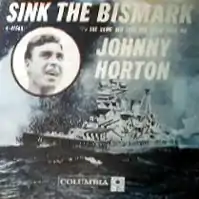Sink the Bismark
"Sink the Bismark" (later "Sink the Bismarck") is a march song by country music singer Johnny Horton and songwriter Tillman Franks, based on the pursuit and eventual sinking of the German battleship Bismarck in May 1941, during World War II. Horton released this song through Columbia Records in 1960, when it reached #3 on the charts. As originally released, the record label used the common misspelling "Bismark"; this error was corrected for later releases of the song. It was inspired by the 1960 British war movie Sink the Bismarck! and was in fact (with the producer John Brabourne's approval) commissioned from Johnny Horton by 20th Century Fox who were worried about the subject's relative obscurity in the United States. For some reason the size comparisons of guns and shells are switched. While the song was used in U.S. theater trailers for the film, it was not used in the film itself. In the UK the song was a hit for Don Lang also in 1960.
| "Sink the Bismark (Sink the Bismarck)" | ||||
|---|---|---|---|---|
 The photo on the "45" Columbia record jacket is from the movie, but depicts the model of HMS Prince of Wales made for the movie. The models made for this movie are very accurate. | ||||
| Single by Johnny Horton | ||||
| B-side | "The Same Old Tale the Crow Told Me" | |||
| Released | 1960 | |||
| Genre | Country | |||
| Length | 3:12 | |||
| Label | Columbia | |||
| Songwriter(s) | Johnny Horton and Tilman Franks | |||
| Producer(s) | Don Law[1] | |||
| Johnny Horton singles chronology | ||||
| ||||
Blues Brothers recording
The song was later recorded by The Blues Brothers for a scene in the movie, The Blues Brothers, but was cut out.[2]
Chart performance
| Chart (1960) | Peak position |
|---|---|
| U.S. Billboard Hot Country Singles | 6 |
| U.S. Billboard Hot 100 | 3 |
| Canadian RPM Top Singles | 1 |
See also
- "PT-109" Another song about a World War II ship
- Parody song "We Didn't Sink The Bismarck" by Homer and Jethro
References
- Billboard Magazine, July 11, 1960
- Sudo, Chuck (July 6, 2012). "Friday Morning Diversion: The Blues Brothers Sing "Sink The Bismarck"". IndieWire. Archived from the original on 23 August 2016. Retrieved 25 November 2012.